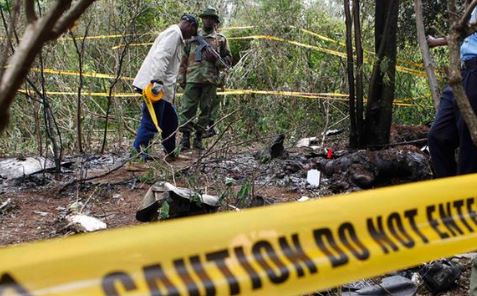Gloomy weather, a ten-minute flight, two cabinet ministers, a plane crash and death.
Eight years ago, the country was shaken and thrown into mourning.
Gloomy weather, a ten-minute flight, two cabinet ministers, a plane crash and death.
Then Interior Cabinet minister George Saitoti (pictured), his assistant minister Orwa Ojode, two pilots and two bodyguards breathed their last in Kibiko Forest in Ngong Hills in the Sunday morning of June 10, 2012.
The Moi-era Vice president and Kibaki-Administration Minister for Internal Security were flying to an harambee in Nyakach when his police helicopter crashed in his Kajiado North Constituency.
Even in death, questions remained and remain unanswered.
Sources close to him told The Standard that the minister had lived on the edge, as if agents of death were stalking him.
The politician, known not to have enemies however, kept a small tight circle. Only a few friends knew where he was at any particular time. He was not one to be found in the city’s social circuit at night. His choice of restaurants? Narrow.
In security circles, he was known for sticking to his trusted bodyguards for years, never allowing them to be replaced.
Even with all the precautions, Saitoti lived in fear.
In a report in 2013, then KTN’s investigative reporter John Allan Namu detailed the events preceding the crash and those after.
From his findings, Namu raised the following questions: Was Saitoti the victim of a crash that nobody could have seen coming or was it more choreographed to the sinister desires of people who wanted him out of the way?

The flight
In the seventh minute of flying, the pilot, Captain Luke Oyugi is heard reporting to Wilson Airport’s control tower that he would be making a landing in one minute. Base said it had received the message and wished the captain and his passengers a good day.
After the communication, instead of proceeding to its destination in Ndhiwa, the helicopter was turned back to Wilson Airport.
Ten minutes after take-off, the helicopter came crashing, killing everybody on board.
Autopsy Report
An autopsy report of all six bodies conducted by Government pathologist Johansen Odour concluded that they died from multiple injuries and burns from the accident.
A Commission of Inquiry formed to investigate his death in 2012 however presented several possibilities as to the cause of death.
- During the inquiry, it was revealed that the helicopter’s battery was not properly maintained. If the battery was overcharged, it could have caused the fire.
- That Saitoti may have suffered severe poisoning. This further formed part of the mystery that could have killed him. Dr Dorothy Njeru and Dr Amritpal Kalsi, Government forensic pathologists who handled the bodies, told the probe team that Saitoti’s body indicated significant levels of carbon monoxide poisoning.
- The commission also reported that pilot error was to blame for the crash, revealing that pilots Luke Oyugi and Nancy Gitwanja who flew the late minister on that fateful Sunday were not fully experienced to fly in the bad weather.
The answers to his death never came, just as fast as the crash happened. And the loose ends? Never tied to date. One of such presented itself during the inquiry, revealing that Saitoti’s mobile phone survived the crash.
It wound in the hands of a police corporal, Evans Kiprotich and was in use for one month without the authorities’ knowledge. Kiprotich was arraigned in court and charged with stealing and handling stolen property and fined Sh30,000.
Saitioti was scheduled to table a report in parliament on the illegal drug trade in Kenya, had he lived.
The answers to all these questions, one can only hope.
Saitoti was Kenya’s longest-serving Vice President during former President Daniel arap Moi’s regime.
He had survived severe food poisoning in the 1990s when the country was rocked by the multi-billion shilling Goldenberg Scandal when he was the finance minister.
Moi would say that the same people who had killed foreign affairs Minister Robert Ouko in February 1990, were behind Saitoti’s poisoning.
After the poisoning, the minister grew so paranoid that somebody had to taste his food.
In Kajiado his nightmare was being poisoned in a crowd especially when he was being welcomed by dancing women groups who would be so close to his comfort.
Saitoti was also set to present a formidable challenge in the 2013 presidential race and had set up a state of the art campaign secretariat.
This article has been referenced to an investigative piece by KTN News: Death in 10 minutes.You can watch the video below:
Credit: Source link